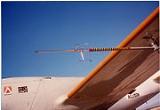
Air data boom
Encyclopedia
An air data boom provides air pressure, temperature, and airflow direction data to data acquisition and air data computers for the computation of aircraft orientation, airspeed, altitude, and related information. Depending on the nature of the activity, air data booms can be used a primary flight instruments or as a "measurement standard" of which primary flight instruments are compared to.
Specialized air data booms may also contain mission-specific sensors such humidity sensors, ice detectors, accelerometers, strain gages, and the like.
Purpose and Overview
An air data boom is used to collect source data during the flight testing of aircraft. The air data boom is mounted on the aircraft in a location that allows for relatively undisturbed air to be measured. To attain such undisturbed air, mounting is usually done on the nose, wing, or upper horizontal stabilizer of the aircraft.Typical Components
Air data booms may contain one, some, or all of these measuring capabilities:- aircraft angle of attack (AOA, alpha)
- aircraft angle of sideslip (AOS, beta)
- static pressure (Ps)
- total pressure (Pt, pitot pressure)
- outside air temperature (OAT)
- total air temperature (TAT)
Specialized air data booms may also contain mission-specific sensors such humidity sensors, ice detectors, accelerometers, strain gages, and the like.
Synonyms
Air data booms are referred to by a variety names to include:- airdata booms
- flight test booms
- nose booms
- nosebooms
- wing booms
- YAPS heads (for yaw-and-pitch sensors)
Supply Sources
Most air data booms are procured from niche manufacturers or designed and built in-house by aircraft manufacturers and flight test organizations.See also
- Flight testFlight testFlight test is a branch of aeronautical engineering that develops and gathers data during flight of an aircraft and then analyzes the data to evaluate the flight characteristics of the aircraft and validate its design, including safety aspects...
- Flight test instrumentationFlight test instrumentationFlight test instrumentation is monitoring and recording equipment fitted to aircraft during flight test. It is mainly used on experimental aircraft, prototype aircraft and development aircraft - both military and civil, and can monitor various parameters from the temperatures of specific...
- Angle of attackAngle of attackAngle of attack is a term used in fluid dynamics to describe the angle between a reference line on a lifting body and the vector representing the relative motion between the lifting body and the fluid through which it is moving...
- Pitot-static systemPitot-static systemA pitot-static system is a system of pressure-sensitive instruments that is most often used in aviation to determine an aircraft's airspeed, Mach number, altitude, and altitude trend. A pitot-static system generally consists of a pitot tube, a static port, and the pitot-static instruments...
- Pitot tubePitot tubeA pitot tube is a pressure measurement instrument used to measure fluid flow velocity. The pitot tube was invented by the French engineer Henri Pitot Ulo in the early 18th century and was modified to its modern form in the mid-19th century by French scientist Henry Darcy...
- Total air temperatureTotal air temperatureTotal air temperature is a term used generally in aviation. In other applications it is called stagnation temperature. Total air temperature is measured by a specially designed temperature probe mounted on the surface of the aircraft. The probe is designed to bring the air to rest relative to the...

